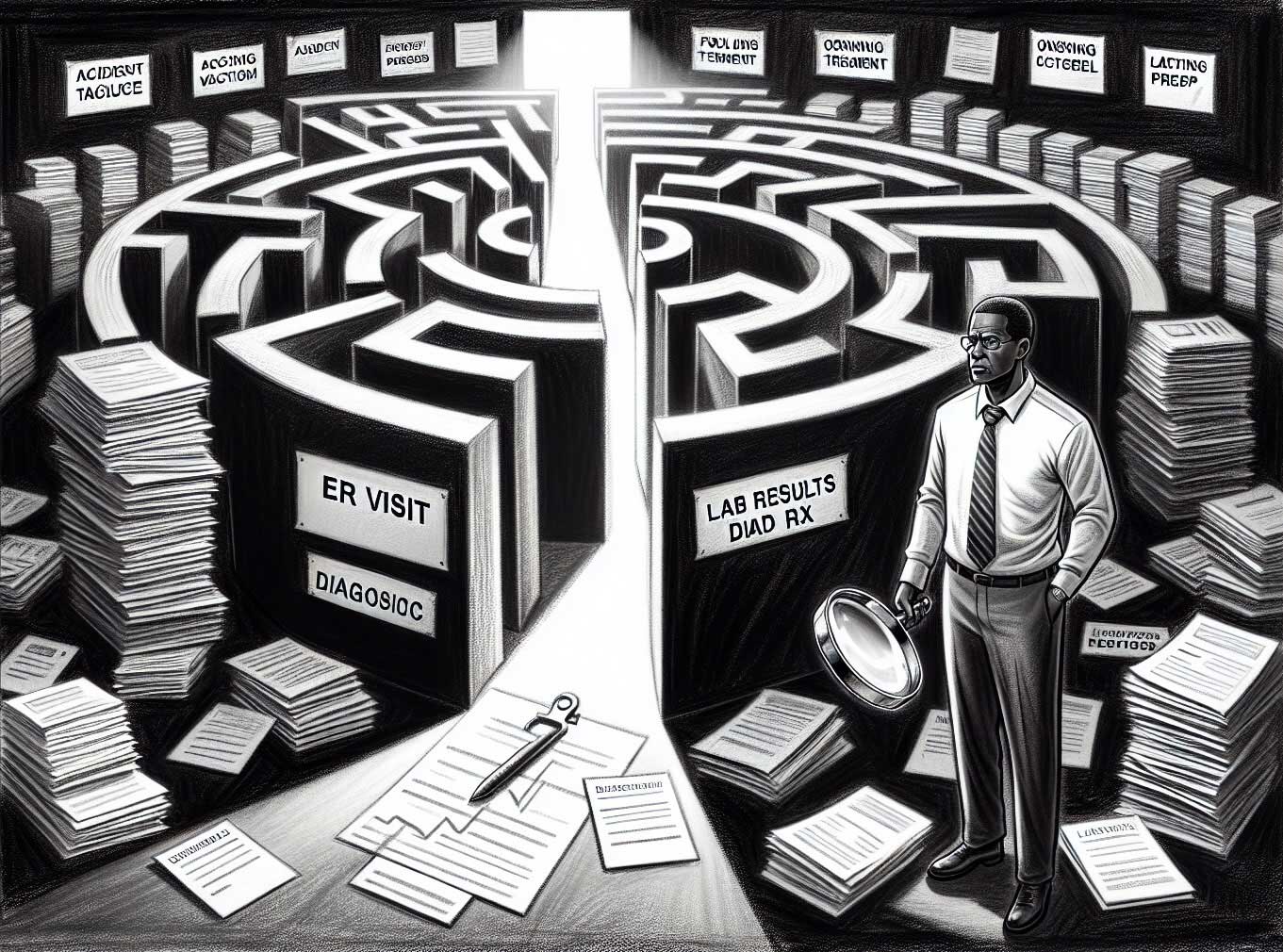You've just received a stack of medical records for your latest case. We're talking hundreds, maybe even thousands of pages spanning the last five years of your client's medical history. Emergency room visits, hospital admissions, clinical notes, diagnostic test results, physical therapy records, prescription logs, and even mental health documentation – it's all there, waiting to be organized into a coherent timeline.
If you're a legal professional handling personal injury or medical malpractice cases, this scenario probably hits close to home. Creating a medical chronology from lots of paperwork is no small feat. It's time-consuming, detail-intensive work that can make even the most seasoned attorneys and paralegals break out in a cold sweat.
But what if using artificial intelligence (AI) was a way to stem the tide?
In this article, we're diving into how AI is tackling the biggest headaches in medical chronology creation. From automating mind-numbing medical record review tasks to giving you a serious edge in the courtroom, we'll show you why AI is becoming the not-so-secret weapon of forward-thinking legal professionals .
Automating Documentation for Managing Overwhelming Workloads
Let's talk about the elephant in the room: the sheer volume of medical data you're dealing with. And, honestly, manually creating a medical record summary is about as fun as watching paint dry.
The problem? Time. There's never enough of it. You're racing against the clock to prepare for depositions , negotiations, or trial, all while trying to make sense of complex medical information. It's a recipe for burnout, and worse, it increases the risk of missing crucial details that could make or break your case.
From a high level, here's how AI generated summaries work: You feed the AI your medical documents - yes, all of them. The system then uses advanced natural language processing to read, understand, and organize the information. It's like having a team of tireless medical professionals who never need coffee breaks and work at superhuman speed.
The result? A comprehensive medical records summarization that would have taken you days (or weeks) to compile manually, delivered in a fraction of the time. We're talking about turning a process that used to eat up your entire week into something that can be done over your lunch break.
But it's not just about speed. These AI systems are designed to identify and highlight relevant information, picking out key medical events, treatments, and diagnoses that might be crucial to your case. It's like having a medical expert and a legal mind working in tandem, sifting through the haystack to give you the needle.
Now, here's a pro tip: The quality of your output depends on the quality of your input. While AI is incredibly powerful, it's not magic. Ensuring your medical records are properly scanned and formatted before feeding them into the system can significantly improve the accuracy and usefulness of your AI-generated summaries.
By leveraging AI for medical chronology, you're not just saving time; you're freeing up your mental bandwidth to focus on what really matters - building a winning strategy for your client. And in the high-stakes world of personal injury and medical malpractice law, that extra edge can make all the difference.
Enhancing Pre-Trial Preparation for Complex Cases
High-stakes medical malpractice cases are a different beast altogether. Your client's medical case chronology might span decades, involving multiple surgeries, a revolving door of specialists, and enough prescription changes to fill a small pharmacy.
The challenge isn't just volume – it's complexity. Each medical condition, every shift in patient care, could be the linchpin of your case. Miss a critical detail, and you might as well hand the opposition a winning lottery ticket.
AI-driven tools are redefining how legal professionals tackle medical chronologies. These sophisticated systems dive deep into the content, providing analysis that goes beyond simple summarization.
The real game-changer is in pattern recognition and anomaly detection. AI can identify trends in treatment that might escape even the most diligent human reviewer. It can flag inconsistencies in care or highlight potential areas of negligence by cross-referencing thousands of data points in seconds.
But the true magic happens when AI connects the dots. Maybe there's a correlation between a medication prescribed years ago and your client's current condition. Or perhaps there's a series of missed diagnoses that, when viewed collectively, paint a clear picture of negligence. These are the kinds of insights that can turn a good case into a great one.
Navigability is another key advantage. Instead of drowning in a sea of disjointed information, you get a clear, chronological breakdown of your client's critical information. Important events, diagnoses, and treatments are organized in a way that tells a story – your client's story.
However, it's crucial to remember that AI is a tool, not a replacement for legal acumen. It's there to augment your expertise, not supplant it. The AI can crunch the data and surface potential leads, but it's your job to take those insights and weave them into a compelling legal narrative.
Risk Mitigation Through Accurate and Consistent AI Outputs
In medical malpractice and personal injury law, accuracy isn't just important – it's everything. A single misinterpreted date or overlooked diagnosis in a medical history could be the difference between winning and losing a case. And let's face it, when you're dealing with hundreds of pages of clinical documentation, human error isn't just possible; it's probable.
This is where AI shines as a powerful ally in risk mitigation. Unlike humans, AI doesn't get tired, distracted, or overwhelmed by the sheer volume of medical records. It approaches each document with the same level of attention, whether it's the first page or the thousandth.
AI systems can flag critical dates within medical records, identify gaps in medical histories, and highlight expert witness contradictions. This ensures you have a clear, accurate picture of your client's medical journey, improving client communication and case understanding. In the courtroom, AI-powered chronology tools can instantly rebut a surprise medical argument from the opposition, turning a potential setback into a victory.
By leveraging AI in your practice, you're not just streamlining workflows – you're creating a robust risk management strategy. In an era where a single oversight can lead to severe professional consequences, AI isn't just a tool; it's your safety net.
Ensuring Data Security and Privacy
Medical record data isn't just sensitive – it's a potential minefield of legal and ethical issues. HIPAA, GDPR, and a host of other regulations could result in hefty fines for slip-ups.
Any AI system worth its salt in the legal world is built with security at its core, featuring bank-level encryption, multi-factor authentication, and regular security audits . AI excels at automated redaction and compliance, identifying and redacting protected health information (PHI) with high accuracy and consistency. These systems are designed to align with relevant regulations, maintaining detailed audit logs of every interaction with the data.
Responsible use of AI means ongoing training for your team on data handling best practices, regular reviews of security protocols, and staying up-to-date with evolving data protection regulations.
Are You In or Out of the AI Revolution in Law?
AI isn't just changing how we handle medical chronologies - it's redefining what's possible in legal practice. The firms embracing this technology aren't just saving time; they're revolutionizing their approach to cases. They're uncovering insights that were previously buried in mountains of paperwork, building stronger arguments, negotiating better settlements, and winning more cases.
As AI continues to evolve, so will its applications in the legal field. The question isn't whether AI will transform legal practice - it's whether you'll be at the forefront of this transformation or playing catch-up.
The choice is yours. Will you stick with the status quo, or will you seize the competitive advantage that AI offers?





